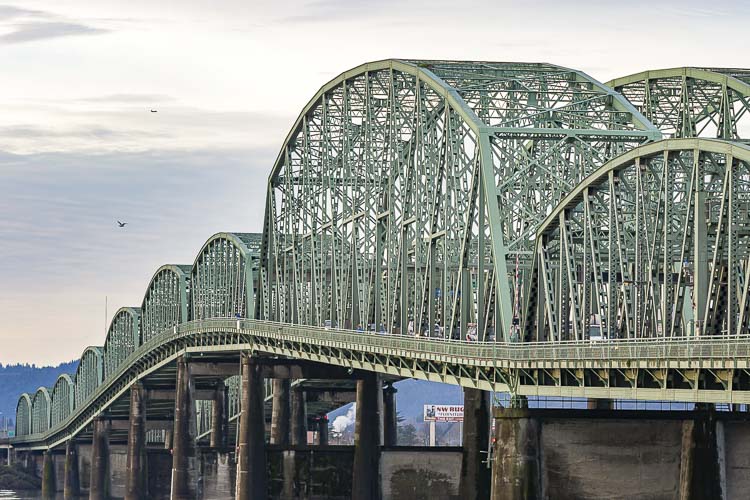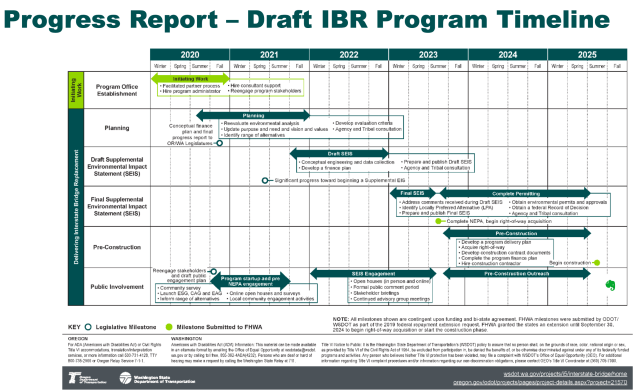
The $7.5 Billion Interstate Bridge Project is two years behind schedule
Joe Cortright
City Observatory
The Interstate Bridge replacement’s Draft SEIS was supposed to be complete in December 2022 — It now won’t be done before December 2024.
This two-year delay means the environmental review has taken twice as long as members of the Interstate Bridge Replacement Program (IBR) promised.
Not to worry, because the consultants will continue billing, and their total costs are now more than $200 million.
Two years behind schedule
The Interstate Bridge replacement project is two years behind schedule. In December 2020, IBR team members told the Oregon and Washington Legislatures that it expected to publish and receive comments on its Supplemental Draft Environmental Impact Statement (SDEIS) by the end of calendar year 2022. This key milestone has to be completed before the project can move on to construction.
As of now, it appears that the IBR may not even release its Draft Supplemental EIS much before the end of 2024, with the comment period possibly extending into the first quarter of 2025. That would put the project more than two years behind its own announced schedule. This schedule implied that it would take two years to complete the DraftSEIS process (from December 2020 to December 2022) — it’s now apparent that completing the Draft SEIS process won’t be completed until December 2024 — a full two years longer, twice as long as described in that schedule.

This schedule spelled out specific milestones that it said it had agreed upon with the US Department of Transportation, i.e. completing the NEPA process by mid-2023, and starting construction in mid-2025.
According to the latest publicly available project schedule (dated May 4, 2023), the IBR team forecasted that the Supplemental Draft Environmental Impact Statement would be released to the public in December 2023, and that a Record of Decision would be issued approximately a year later (in December 2024), and that construction would start a year later in December 2025.

That schedule shows that it will take two full years to move from issuing the SDEIS to actually starting bridge construction. If the SDEIS is issued in December of this year (2024), that means that a ROD would be likely issued in December 2025, and construction would start in December 2026 – a year later than forecast in 2023, and a year and a half behind the announced 2020 schedule.
There’s little reason to believe the project can meet that schedule. As the experience of the I-5 Rose Quarter project illustrates, completing the environmental review is no guarantee that the project will move ahead quickly. ODOT got its initial “finding of no significant impact” in 2020, but then had to withdraw it, and four years later, there’s still no assured schedule of when the project will move forward. The previous project, the Columbia River Crossing, finished its draft environmental impact statement in 2008, but didn’t obtain a record of decision until 2011, before finally collapsing three years later in 2014. The plan to move from a draft supplemental environmental impact statement to a record of decision in just a few months seems plainly unrealistic, given this history.
Deadlines disappear down the memory hole
Transportation projects are claimed to always be “on schedule,” because transportation departments routinely change the schedule (move the goalposts) to reflect delays. The project has repeatedly changed the deadline for this key environmental report — but has never acknowledged that the original project schedule called for it to be completed in 2022.
In October, 2023, The Columbian reported:
I-5 bridge environmental impact statement delayed, again — this time until 2024.
Administrator: ‘We’re still on time and on schedule at this point’
On February 24, 2024, The Columbian reported that the EIS would be available in late April of 2024.
The Columbian reported that the original deadline for the EIS was summer of 2023.
In April 2024, the Columbian told its readers:
“Originally intended to be released last summer [2023], the document’s release has been pushed back a handful of times.”
But The Columbian dutifully repeated IBR claims that the project remains on schedule, even though the release of the key environmental document is now more than two years behind the schedule announced by the project in 2020.
State transportation departments simply shamelessly re-write their schedules, and never own up to the fact that they are spending more money, and taking more time than promised when the project was originally announced. The Oregon Department of Transportation has done this with its Newberg-Dundee Bypass — a years-delayed project that is still only half completed and has already gone well over its originally announced budget — claiming at a ribbon-cutting ceremony that the project was “on time and under budget.” Similarly, ODOT spent $1 million on a McKinsey report on its management problems which conveniently omitted details of the department’s largest cost-overrun—a project that was several years behind schedule and cost nearly 3 times its original budget.
No accountability or consequence: Connected consultants keep on billing
Highway agencies are apparently without either honesty or accountability for blowing through schedules and budgets. And their consultants are more than happy to keep working — and keep billing — no matter how long the project takes. The Interstate Bridge Project is a warmed-over version of the failed Columbia River Crossing — which itself reaped nearly $200 million in fees for consultants a decade ago. Oregon and Washington have already awarded another $200 million for consulting work on the project, even though IBR Administrator Greg Johnson has characterized the IBR as “basically the same project” as the old CRC. Meanwhile, the cost of the project has increased from $4.8 billion to $7.5 billion and seems likely to go as high as $9 billion. There are no consequences for cost overruns or schedule delays, except that Johnson’s former employer, the engineering firm WSP has reaped more than $75 million in fees, and stands to get even more money as the project drags on.
Note: This commentary has been revised to more accurately reflect current information on the likely release of the Draft Supplemental Environmental Impact Statement. In a response to a public records request received Monday (May 6), Washington State Department of Transportation officials say that the project has produced no new schedule for the project in the past five months. Press accounts say only that IBR officials say the DSEIS will come out “later this year.”
Also read:
- Busy pavement season ahead on Vancouver streetsThe city of Vancouver is set to repave and preserve 76 lane miles across 20 neighborhoods in summer 2025, with ADA upgrades and community notices throughout.
- State representative: Expect sticker shock when Interstate Bridge project officials reveal price, tolling plansAt a town hall in Battle Ground, Rep. John Ley warned of major cost increases and tolling burdens tied to the Interstate Bridge replacement project.
- Opinion: Washington state lawmakers increase the cost of driving – againBob Pishue of Mountain States Policy Center argues that new vehicle and fuel taxes in Washington will raise driving costs while diverting funds away from roads.
- Overnight full closure of I-5 near Woodland for bridge inspection, May 6WSDOT will fully close southbound I-5 near Woodland overnight on Tuesday, May 6 for a bridge inspection using a chain drag test.
- Opinion: Do we still need TriMet?John A. Charles Jr. of the Cascade Policy Institute argues that TriMet should halt expansion plans and prepare for major service reductions in response to falling ridership and rising costs.









